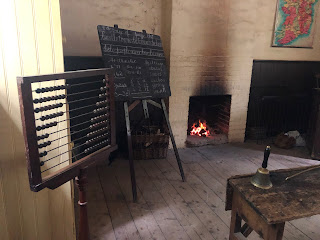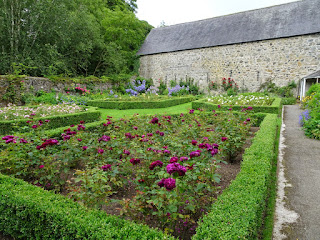After an amazing breakfast, we headed by car to the Ulster Folk Museum located just a few miles down the road from where we are staying.
I had prebooked tickets, as the site made it sound urgent, so I was pleasantly surprised to see only three other cars in the parking lot when we arrived. So far, we've managed to quite successfully enjoy the area without crowds of people. Here's hoping that trend continues, because we do love the personal attention that comes from being the lone visitors in any given space.
The museum is cleverly set up, with a very large, open display that walks the visitor through time, explaining the circumstances that led to mass migration from the Ulster area. For those not familiar, Ulster is an area in Ireland that consists of 9 northern counties, which is primarily the area of Ireland that experience the majority of emigration.
It also features a very large, open air outside museum, that physically walks one through the life in Ireland, the journey to the United States, and, finally the "New World" experienced by these Irish immigrants.
We were quite surprised to see a Conestoga Wagon, made in Lancaster, PA, standing at the entrance to the time line experience.
We soon learned that the reason it was there was to represent the mode of transport in the early 1800s, from the Port of Baltimore to the Pittsburgh, PA area. We found this to be especially interesting since we live not far from where these Conestoga Wagons were constructed back in the day.
Three families were highlighted in the museum, each emigrating in the early 1800s from the Tyrone area, to various areas of the United States, and each for different personal reasons.
The first, Thomas Mellon of Mellon Bank fame in Pittsburgh, PA. He was the son of a farmer, Andrew Mellon, who decided to move to Turtle Creek at the encouragement of his parents who had emigrated previously. Thomas Mellon was born in Tyrone, and his family home still stands on the premises of the museum. It is considered to be the most important feature in the museum, since it was Thomas' son who donated the house and set up the trust for this amazing venue. Thomas and his parents arrived at the port of Baltimore in the early 18002, and used the Conestoga Wagon as transport to Turtle Creek.
Thomas decided as a youngster, that he did not want to pursue life as a farmer, so he attended the University of Pittsburgh, achieved a law degree, and set up Mellon Bank later in life.
The second family featured was that of John Joseph Hughes. John's family felt persecuted as Catholics, and left Tyrone for Maryland in the early 1800's as well. John was originally employed as a gardener fo Mount St. Mary's Seminary in Emmitsburg, Maryland. He would eventually become ordained as a priest, which led, over time, to his being appointed as Arch Bishop of New York. During his time in this role, he worked hard to defend the rights of the many Irish Catholic immigrants.
Finally, Hugh and Robert Campbell left Tyrone during the same time period, settling in St. Louis, MO, where they became successful businessman. They chose to emigrate since neither were due to inherit from their father, due to being younger sons.
None of these men left Ireland due to physical hardship in their homeland, and all three went on to become famous Americans. The museum is certain to note that there were many forced to emigrate due to unfair land taxes, or starvation, who did not fare as well as these three men. The streets were NOT lined with gold as some would claim to encourage others to follow, and this cartoon gives an humorous example at just how a story can be embellished to make a situation appear far grander than it is.
There was a wealth of information to learn, and we both came out of there with a real appreciation for what the average emigrant had to endure. There were numerous dioramas to enhance the experience.
We even learned about the changes that occurred in transport, from sailing vessels that took 8 weeks to cross the ocean, to steam boats that shortened the trip to 12 days.
Outside, the museum has original houses that were relocated on the land, in addition to the Mellon family home, which stands in its original location. Here you see a Single Room Family Cabin featuring a handsome Irishman (kind of) in front.
Weaver's cottage
The Mellon homestead, where Thomas Mellon was born
and the interior kitchen.
A schoolhouse transported from 3 miles down the road
complete with desks
and learning equipment (and a cozy fire as well).
We were told that students were required to bring a block of "Turf" to the classroom in order to be admitted for study. It is some kind of peat that is dug up from the ground in the area. If a student did not have the required Turf, they were "turfed out", meaning that they were not permitted in the school. This brought a lot of chuckles from the Irish visitors in attendance. I had not personally heard that phrase, but obviously it is frequently used here due to the reaction.
The museum also featured the original homes of the Hughes and Campbell families.
From here, we walked through a recreated "typical" Irish village where the emigrant would have walked. The Mountjoy post office was moved from a mile down the road, stone by stone, rebuilt as the original structure.
Around the corner, we walked down this quaint village street that features the original fronts of various establishments that had existed. Even the road was authentic!
We were told by the local chemist (a volunteer re-enactor), that the emigrant would have ventured down this street by "shank pony". Of course, I had no idea what that was. He explained that it was a term used for walking. The "shanks" of their legs were ponied by their feet. Did you know that?
From there, we entered a dark alley that led us to a recreated transport ship.
all set up to give one the experience of the emigrant.
I was actually quite surprised by the size of the beds. I had presumed them to be really tight quarters, but it could very well be that more than one person was expected to sleep in each of those beds.
Upon debarkation, we found ourselves in a recreated town near the port of Baltimore.
At this point, we continued to walk through fields featuring log cabins from various areas.
This one a Pennsylvania farmhouse.
One from West Virginia
and, finally, the Tennessee Rogan Plantation house, which was, surprising to me, made of brick.
At this point, we felt that we had traveled far enough in time, so we decided to hit the road and drive east to a different sort of plantation: Springhill, a 17th Century family manor house. And, it was here that I learned that the term, Plantation, came from the "planting" of Scots to this area of Ireland in the mid 17th century.
It featured a lovely Dutch Garden
some stunning interiors
and a round tower at the end of a long row of Beech Trees.
I couldn't resist setting up a photo using my Apple watch. How fun is that?
This is a National Trust Site, so, of course, tea and scones were in order. (Plus all of that walking earned some refreshment.)
Not far from Springhill stands the tallest Cross in Northern Ireland and the third highest in all of that country, constructed in the 10th century. It is situated near Arbroe Abbey along the shores of Loch Neagh.
The cross features many biblical scenes, but it's a bit difficult to see the figures that the information claims. The stone is well weathered due to its location in the elements. But, one certainly gets a feel for the amount of work that would have gone into constructing such a sight.
The loch in the background was stunning.
and there was wildlife to keep one's attention for a little while.
Then, the midges moved in, so we moved out. But not before I captured a photo of this cross among the graves in the cemetery. I found it to be very unique and quite beautiful.
We headed back to our hotel where we enjoyed a delicious dinner in the restaurant.
Afterwards, I sipped a delicious Irish Coffee
while being entertained by an Irish Singer, singing country-western songs, who was apparently on stage for the evening.
I'd say that was quite the ending to an already full day.













































No comments:
Post a Comment